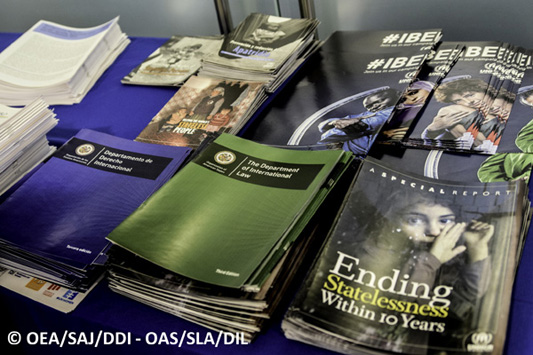
This past April 6, the Department of International Law
(DIL) (Secretariat for Legal Affairs) of the OAS, in its capacity as Technical Secretariat for the Inter-American Juridical Committee (CJI),
presented to the Committee on Juridical and Political Affairs (CAJP) of the Permanent Council of the OAS, the “Guide for the Protection of Stateless Persons” (Guide), adopted by the CJI in August 2015, at the request of the OAS General Assembly, which had entrusted it, in 2014, with the development of a Guide on this matter in accordance with international standards thereon.
In 2016, the General Assembly—which since 2010
has been adopting resolutions having to do with
statelessness, underscoring the importance of
the matter and establishing international
standards thereon—asked the CAJP to give due
consideration to this Guide.
In the Guide, the CJI urges the member states
to: Ratify the 1954 Convention on the Status of
Stateless Persons and the 1961 Convention on the
Reduction of Statelessness; support the UNHCR’s
Model Law for the Protection of
Stateless Persons (2012), which has
been replaced by a February 2017 version
entitled “Draft Articles on Protecting and
Facilitating the Naturalization of Stateless
Persons” (Draft Articles); and develop an
effective procedure for the protection of
stateless persons.
In his presentation, the Director of the DIL
also discussed his recent participation in the
“Statelessness Regional Course: Americas focus,”
organized by the Institute on Statelessness and
Inclusion, the Open Society Justice Initiative,
the Americas Network on Nationality and
Statelessness, UNHCR, and the Ministry of
Foreign Affairs of Colombia.
Although there are fewer stateless persons in
our Hemisphere than in other regions, constant
flows of migrants and the sheer number of people
who are currently refugees could eventually lead
to situations of statelessness. Every 10 minutes
across the globe, a child is born stateless. The
data, however, remain scarce and according to
estimates, the number of individuals in this
situation is far higher. The DIL underscored
that it is for this reason that it is important
to engage in joint efforts to prevent situations
from arising in which people lack a nationality;
and should a person lack a nationality, to
ensure that effective mechanisms are in place to
recognize his or her status as stateless and
guarantee that the rights inherent to that
status are protected; and that once the status
of statelessness has been recognized, to ensure
that the best efforts possible are made to help
such individuals secure the respective
naturalization.
He also noted that the “Draft Articles” adopted
by UNHCR and recommended in the
CJI “Guide” are an important reference document
that could be taken into account by the member
states when implementing domestic legislation in
this area. The Draft Articles are a tool
available to the States to help them implement
the 2014 Brazil Declaration “A Framework for
Cooperation and Regional Solidarity to
Strengthen the International Protection of
Refugees, Displaced and Stateless Persons in
Latin America and the Caribbean,” and the Brazil
Plan of Action “A Common Roadmap to Strengthen
Protection and Promote Sustainable Solutions for
Refugees, Displaced and Stateless Persons in
Latin America and the Caribbean within a
Framework of Cooperation and Solidarity,”
adopted in December 2014, inasmuch as they
recommend that States adopt domestic regulatory
protection frameworks, develop just and
efficient procedures for determining
statelessness, and facilitate the naturalization
of stateless migrants.
The CJI is making the “Guide
for the Protection of Stateless Persons”
available to the countries of the region as a
source of recommendations and guidance, in order
to enhance the progress achieved in the region
on this matter and surmount the obstacles and
weaknesses that still persist.
»
See text of the resolution “Guide for the
Protection of Stateless Persons,” CJI/RES.218
(LXXXVII-O/15), August 7, 2015.